Boulogne-sur-Mer
| Boulogne-sur-Mer | ||
|---|---|---|
|
A general view from the Brecquerecque Quarter: The lighthouse, the bell tower and the English Channel | ||
| ||
 Boulogne-sur-Mer | ||
|
Location within Hauts-de-France region 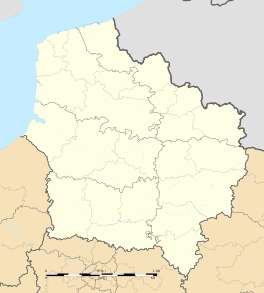 Boulogne-sur-Mer | ||
| Coordinates: 50°43′35″N 1°36′53″E / 50.7264°N 1.6147°ECoordinates: 50°43′35″N 1°36′53″E / 50.7264°N 1.6147°E | ||
| Country | France | |
| Region | Hauts-de-France | |
| Department | Pas-de-Calais | |
| Government | ||
| • Mayor (2014–2020) | Frédéric Cuvillier (PS) | |
| Area1 | 8.42 km2 (3.25 sq mi) | |
| Population (2013)2 | 42,537 | |
| • Rank | 2nd in the department, 11th in the region and 60th in France | |
| • Density | 5,100/km2 (13,000/sq mi) | |
| • Metro (2012) | 133,062 | |
| Time zone | CET (UTC+1) | |
| • Summer (DST) | CEST (UTC+2) | |
| INSEE/Postal code | 62160 / 62200 | |
| Elevation | 0–110 m (0–361 ft) | |
| Website | http://www.tourisme-boulonnais.fr/uk/ | |
|
1 French Land Register data, which excludes lakes, ponds, glaciers > 1 km² (0.386 sq mi or 247 acres) and river estuaries. 2 Population without double counting: residents of multiple communes (e.g., students and military personnel) only counted once. | ||
Boulogne-sur-Mer (French pronunciation: [bu.lɔɲ.syʁ.mɛʁ], Latin: Gesoriacum or Bononia, Dutch: Bonen), often called Boulogne (UK /buːˈlɔɪn/), is a city in Northern France. It is a sub-prefecture of the department of Pas-de-Calais. Boulogne lies on the Côte d'Opale, a tourist coast on the English Channel, and is the most-visited location in its region after the Lille conurbation.[1] Boulogne is its department's second-largest city after Calais,[2] and the 60th largest in France.[3] It is also the country's largest fishing port, specialising in herring.[4]
Boulogne was the major Roman port for trade and communication with Britain. After a period of Germanic presence following the collapse of the Empire, Boulogne was at the centre of an eponymous county of the Kingdom of France during the Middle Ages, and was occupied by the Kingdom of England numerous times due to conflict between the two nations.
The city's 12th-century belfry is recognised by UNESCO as a World Heritage Site,[5] while another popular attraction is the marine conservation centre Nausicaa.
Name
The French name Boulogne derives from the Latin Bononia, which was also the Roman name for Bologna in Italy. Both places—and Vindobona (Vienna)—are thought to have derived from native Celtic placenames, with bona possibly meaning "foundation", "citadel", or "granary". The French epithet sur-Mer ("on-the-sea") distinguishes the city from Boulogne-Billancourt on the edge of Paris. In turn, the Boulogne in Boulogne-Billancourt originates from a church there dedicated to Notre-Dame de Boulogne, "Our Lady of Boulogne[-sur-Mer]".
Geography
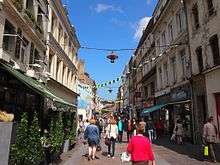
Location
Boulogne-sur-Mer is in Northern France, at the edge of the Channel and in the mouth of the river "Liane". As the crow flies, Boulogne is approximately at 30 kilometres (19 miles) from Calais, 50 kilometres (31 miles) from Folkestone, 100 kilometres (62 miles) from Lille and Amiens, 150 kilometres (93 miles) from Rouen and 215 kilometres (134 miles) from Paris.
Boulogne is a relatively important city of the North, exercising an influence on the "Boulonnais" territory (74 towns and villages which surround Boulogne). The coast consists of important tourist natural sites, like the capes Gris Nez and Blanc Nez (which are the closest points of France to England), and attractive seaside resorts like Wimereux, Wissant, Hardelot and Le Touquet. The hinterland is mainly rural and agricultural.
Transport
Boulogne is close to the A16 motorway (Paris-Amiens-Calais-Dunkerque). Metropolitan bus services are operated by "Marinéo". The company Flixbus propose a bus line connecting Paris to Boulogne. There are coach services to Calais and Dunkerque.
The city has railway stations, which the most important is Boulogne-Ville station, located in the south of the city. Boulogne-Tintelleries station is used for regional transit. It is located near the university and the city centre. The former Boulogne-Maritime and Boulogne-Aéroglisseurs stations served as a boat connection (to England) for the railway.
Boulogne currently has no cross channel ferry services since the closure of the route to Dover by LD Lines in 2010.
Urbanization

The city is divided into several parts :
- City centre : groups historic and administrative buildings, and also accommodations, stores, banks, churches, pedestrian streets and places.
- Fortified town : old-town where are a lot of historic monuments (the castle-museum, the basilica, the belfry, the imperial palace) and also the city hall and the courthouse. it is surrounded by 13th-century ramparts very appreciated today by walkers.
- Gambetta-Sainte-Beuve : tourist area situated in the northwest of the city, on the edge of the beach and the recreational harbour.
- Capécure : economic and industrial area, situated in the west of the city, around the harbour.
- Saint-Pierre (Saint Peter) : former neighborhood of the fishermen, destroyed during the World War II and reconstructed after.
- Chemin Vert (Green path) : zone borned in the 1950s, knowing today poverty and unemployment. it is the neighborhood of Franck Ribéry.
- Dernier Sou (Last penny) : residential area situated in the east of the city.
- Beaurepaire (Beautiful hideout) : residential area situated in the north of the city.
- Bréquerecque : residential area situated in the south of the city.
Climate
| Climate data for Boulogne-sur-Mer (1981–2010 averages) | |||||||||||||
|---|---|---|---|---|---|---|---|---|---|---|---|---|---|
| Month | Jan | Feb | Mar | Apr | May | Jun | Jul | Aug | Sep | Oct | Nov | Dec | Year |
| Record high °C (°F) | 15.0 (59) |
17.4 (63.3) |
22.6 (72.7) |
26.0 (78.8) |
31.2 (88.2) |
32.6 (90.7) |
35.4 (95.7) |
34.8 (94.6) |
30.8 (87.4) |
27.2 (81) |
19.1 (66.4) |
17.2 (63) |
35.4 (95.7) |
| Average high °C (°F) | 6.8 (44.2) |
6.9 (44.4) |
9.3 (48.7) |
12.0 (53.6) |
15.4 (59.7) |
17.7 (63.9) |
20.1 (68.2) |
20.5 (68.9) |
18.3 (64.9) |
14.8 (58.6) |
10.5 (50.9) |
7.5 (45.5) |
13.4 (56.1) |
| Average low °C (°F) | 2.9 (37.2) |
2.7 (36.9) |
4.6 (40.3) |
6.3 (43.3) |
9.5 (49.1) |
12.1 (53.8) |
14.4 (57.9) |
14.9 (58.8) |
13.0 (55.4) |
10.0 (50) |
6.3 (43.3) |
3.5 (38.3) |
8.4 (47.1) |
| Record low °C (°F) | −13.4 (7.9) |
−13.6 (7.5) |
−7.8 (18) |
−2.0 (28.4) |
1.6 (34.9) |
4.0 (39.2) |
8.0 (46.4) |
9.0 (48.2) |
5.8 (42.4) |
−1.0 (30.2) |
−5.6 (21.9) |
−9.6 (14.7) |
−13.6 (7.5) |
| Average precipitation mm (inches) | 67.9 (2.673) |
46.7 (1.839) |
53.3 (2.098) |
51.4 (2.024) |
55.8 (2.197) |
50.7 (1.996) |
53.5 (2.106) |
50.9 (2.004) |
68.8 (2.709) |
94.5 (3.72) |
97.0 (3.819) |
87.4 (3.441) |
777.9 (30.626) |
| Average precipitation days | 13.0 | 9.5 | 10.3 | 9.4 | 9.3 | 8.5 | 8.3 | 7.9 | 10.2 | 12.7 | 13.3 | 12.9 | 125.3 |
| Average snowy days | 3.4 | 3.3 | 2.4 | 0.8 | 0.0 | 0.0 | 0.0 | 0.0 | 0.0 | 0.0 | 1.0 | 1.8 | 12.7 |
| Average relative humidity (%) | 87 | 85 | 84 | 81 | 81 | 81 | 82 | 81 | 82 | 83 | 85 | 87 | 83.3 |
| Source #1: Météo France[6][7] | |||||||||||||
| Source #2: Infoclimat.fr (humidity and snowy days, 1961–1990)[8] | |||||||||||||
History
Origin of the city
The foundation of the city known to the Romans as Gesoriacum is credited to the Celtic Boii. In the past, it was sometimes conflated with Caesar's Portus Itius, but that is now thought to have been a site near Calais which has since silted up. From the time of Claudius's invasion in AD 43, Gesoriacum formed the major port connecting the rest of the empire to Britain. It was the chief base of the Roman navy's Britannic fleet until the rebellion of its admiral Carausius in 286. As part of the imperial response, the junior emperor Constantius Chlorus successfully besieged it by land and sea in 293.[9] The name of the settlement was changed to Bononia at some point between the sack of Gesoriacum and 310, possibly as a consequence of its refounding or possibly by the replacement of the sacked and lower-lying city by another nearby community.[10]
The city was an important town of the Morini, and Zosimus called it Germanorum ("Germanic-speaking") at the end of the 4th century.[11]
Middle Ages

In the Middle Ages Boulogne was the capital of an eponymous county, founded in the mid-9th century. An important Count, Eustace II, assisted William the Conqueror in his conquest of England. His wife founded the city's Notre Dame cathedral, which became a site of pilgrimage from the 12th century onwards, attended by fourteen French kings and five of England. It was an important whaling center prior to 1121.[12] The city survived on herring fishing and received its municipal charter from Count Renaud of Dammartin in 1203.[9]
The area was fought over by the French and the English, including several English occupations during the course of the Hundred Years War. Boulogne was again occupied by the English from 1544 to 1550. In 1550, The Peace of Boulogne ended the war of England with Scotland and France. France bought back Boulogne for 400,000 crowns. A culture of smuggling was present in the city until 1659, when French gains in Flanders from the Treaty of the Pyrenees moved the border northwards.
The Napoleonic period
Boulogne received its current status as a subprefecture of the Pas-de-Calais department in 1800 due to the territorial re-organisation in Revolutionary France. Three years later, it was given the title of an Imperial City (Ville Impériale).[9]
The 19th century was a prosperous one for Boulogne, which became a bathing resort for wealthy Parisians after the completion of a railway line to the French capital.[9] In the 19th century, the Basilica of Notre-Dame de Boulogne was reconstructed by the priest Benoit Haffreingue, who claimed to have received a call from God to reconstruct the town's ruined basilica. During the Napoleonic Wars, Napoleon amassed La Grande Armée in Boulogne to invade the United Kingdom in 1805. However, his plans were halted by other European matters and the supremacy of the Royal Navy.
A nephew of Bonaparte, Louis-Napoleon Bonaparte, later Napoleon III, returned to France in secret from his exile in England, passing through Boulogne in August 1840. He was later jailed for trying to lead a revolt in Strasbourg.
The two world wars
During the First World War, this was the debarkation port for the first unit of the British Expeditionary Force to land in France, and for many others thereafter.

Boulogne, was one of the three base ports most extensively used by the Commonwealth armies on the Western Front throughout the First World War. It was closed and cleared on the 27 August 1914 when the Allies were forced to fall back ahead of the German advance, but was opened again in October and from that month to the end of the war, Boulogne and Wimereux formed one of the chief hospital areas.
Until June 1918, the dead from the hospitals at Boulogne itself were buried in the Cimetiere de L'Est, one of the town's cemeteries, the Commonwealth graves forming a long, narrow strip along the right hand edge of the cemetery. In the spring of 1918, it was found that space was running short in the Eastern Cemetery in spite of repeated extensions to the south, and the site of the new cemetery at Terlincthun was chosen.[13]
It also was the site of an Allied (French and British) armaments production conference.
On 22 May 1940 during the Battle of France, two British Guards battalions and some pioneers attempted to defend Boulogne against an attack by the German 2nd Panzer Division. Despite fierce fighting, the British were overwhelmed and the survivors were evacuated by Royal Navy destroyers while under direct German gunfire.[14] On 15 June 1944, 297 planes (155 Avro Lancasters, 130 Handley Page Halifaxes, and 12 De Havilland Mosquitos) of the Royal Air Force bombed Boulogne harbour to suppress German naval activity following D-Day. Some of the Lancasters carried Tallboy bombs, and as a result, the harbour and the surrounding area were completely destroyed. In August, 1944 the town was declared a "fortress" by Adolf Hitler, but it succumbed to assault and liberation by the 3rd Canadian Infantry Division in September. In one incident, a French civilian guided the Canadians to a "secret passage" leading into the walled old town and by-passing the German defenders.[15]
To replace the destroyed urban infrastructure, affordable housing and public facility projects in functional, brutalist building styles were carried out in the 1950s and 60s. The harbour, therefore, is not typical of a Northern French harbour.
Sights
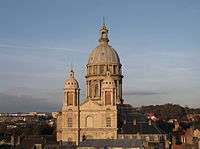
Boulogne's 12th century belfry is one of 56 in northeastern France and Belgium with shared World Heritage Site status. It is the oldest building in the upper city, and currently serves as the home to a museum of Celtic remains from the Roman occupation. Founded as the Count's dungeon, the top floor was added in the 13th century. Damage by a fire in 1712 was built over by 1734.[5]
Other than the belfry there are also the following sights:
- Medieval walls long 1,500 metres with 4 gates and 17 towers from 13th century
- Medieval castle, whose foundations date to Roman times. It houses an Egyptian art collection
- Gothic church of St. Nicholas, housing several 15th century statues
- Cathedral basilica of Notre-Dame, with a dome standing at over 100 m. The crypt is one of the largest in France, and has Roman, Romanesque and Gothic elements.
- Opened in 1991, Nausicaä - The French National Sea Centre is a science centre entirely dedicated to the relationship between mankind and the sea. It houses Aquaria, exhibitions on the marine fauna, and the exploitation and management of marine resources (fisheries, aquaculture, coastal planning, maritime transport, exploitation of energies and mineral, tourism).
- The Boulogne Eastern Cemetery, created during the Great War
- Colonne de la Grande Armée - Statue of Napoleon I
Official website: Tourism in Boulogne sur Mer
Official website: Tourism in Boulogne sur Mer and the Boulonnais region
Economy
Boulogne-sur-Mer is an important fishing port, with 7,000 inhabitants deriving part, or all, of their livelihoods from fishing.
IFREMER (the French Research Institute for Exploitation of the Sea) and the Pasteur Institute are located in Boulogne Port.
Certain brands, including Crown and Findus, are based in Boulogne
Media
- Radio : France Bleu Nord, Virgin Radio Côte d'Opale
- Television : France 3 Côte d'Opale
- Print : La Voix du Nord (édition de Boulogne sur Mer), La Semaine dans le Boulonnais, Touzazimut
Events
In the year 1905 the First Esperanto Universal Congress was held in Boulogne-sur-Mer. L. L. Zamenhof, the creator of Esperanto, was among the attendees. In the 2005, there was a grand anniversary meeting, to mark the centenary, with more than 500 attendees.
Administration
- Boulogne is the seat of the Communauté d'agglomération du Boulonnais
| Duration | Name | Party | Particularities |
|---|---|---|---|
| 2014–2020 | Frédéric Cuvillier | PS | Deputy, Minister |
| 2012-2014 | Mireille Hingrez-Céréda | PS | |
| 2004–2012 | Frédéric Cuvillier | PS | Deputy, Minister |
| 1996–2004 | Guy Lengagne | PS | Deputy, Minister |
| 1989–1996 | Jean Muselet | Conservative | |
| 1977–1989 | Guy Lengagne | PS | Deputy, Minister |
| 1945–1977 | Henri Henneguelle | PS | |
| Past mayors are unknown. | |||
Population
| Historical population | ||
|---|---|---|
| Year | Pop. | ±% |
| 1936 | 52,371 | — |
| 1954 | 34,885 | −33.4% |
| 1962 | 49,283 | +41.3% |
| 1968 | 49,288 | +0.0% |
| 1975 | 48,440 | −1.7% |
| 1982 | 47,653 | −1.6% |
| 1990 | 43,678 | −8.3% |
| 1999 | 44,859 | +2.7% |
| 2006 | 43,700 | −2.6% |
| 2009 | 43,310 | −0.9% |
| 2012 | 42,785 | −1.2% |
Education
Boulogne-sur-Mer hosts one of the oldest Universités de l'été - summer courses in French language and culture.
The Saint-Louis building of the University of the Côte d'Opale's Boulogne campus opened its doors in 1991, on the site of the former St. Louis Hospital, the front entrance to which remains a predominant architectural feature. Its 6 major specialisms are Modern Languages, French Literature, Sport, Law, History and Economics. The university is situated in the town centre, about 5 minutes from the Boulogne Tintelleries railway station.
University
- Campus University of the Littoral Opal Coast (Saint-Louis, Grand-Rue and Capérure site), member of Université Lille Nord de France.
Public primary and secondary
- High schools : Lycée Auguste Mariette, Edouard Branly, Cazin (professional).
- College : College Langevin, Angelier, Daunou.
Private primary and secondary
- High schools: Lycée Nazareth, Haffreingue, Saint-Joseph
- College: College Godefroy de Bouillon, Haffreingue, Nazareth, Saint-Joseph
Health
Two health centres are located in Boulogne, the public Hospital Duchenne and the private Clinique de la côte d'opale.
Sports
.jpg)
Boulogne's football club, US Boulogne Côte d'Opale (US refers to Union Sportive), is one of the oldest in France due to the city's proximity to England, founded in 1898. The club currently play in the third tier, the Championnat National, and host home matches at the 14,500-capacity Stade de la Libération.[16] Boulogne native and FIFA World Cup finalist Franck Ribéry began his career at the club.[17]
Basketball teams in Boulogne include Stade Olympique Maritime Boulonnais and ESSM of Pro B (second-tier men's professional basketball league in France).
Culture
- The Château de Boulogne-sur-Mer (now a castle museum) of Boulogne, in the fortified town, houses the most important exhibition of masks from Alaska in the world, the second largest collection of Greek ceramics in France (after the Louvre), collections of Roman and medieval sculptures, paintings (15th-20th century), an Egyptian collection, African Arts etc. As these collections are exhibited in a medieval castle, one can also discover the Roman walls (in the underground) as well as rooms built in the 13th century (La Barbière, banqueting hall, chapel, covered parapet walk...)
- La Casa San Martin is currently a museum where José de San Martín the leader of independence struggle in Argentina (also Chile and Peru) died in 1850, from 1930 to 1967 this house was the consulate of Argentina in France. There is a statue dedicated to his colleague Simón Bolívar, other liberator of South America in the revolutions against Spanish colonial rule in the 1810s. Bolivar planned to head in exile to this very part of France before his death in 1830. Historic emigration in the 19th century from the Nord-Pas de Calais region to Argentina and Chile can explain some cultural ties with South America of the Boulognais and Latino/Ibero-American culture.
- Nausicaä, the French national sealife centre.
Food
As an international maritime port on the English Channel (La Manche), the town of Boulogne-sur-Mer has European and American influences in local cuisine. They include:
- Welsh rarebit (from Wales, United Kingdom)
- Sandwich américain (an American sandwich introduced from the USA)
- Kipper (Flemish: smoked herring)
Notable people
Born in Boulogne

- Matilda of Boulogne (1105–1152), Countess of Boulogne and queen consort of England
- Michel Le Quien (1661–1733), monk and historian.
- Pierre Claude François Daunou (1761–1840), politician and historian
- Frédéric Sauvage (1786–1857), engineer and inventor of the propeller
- Charles Augustin Sainte-Beuve (1804–1869), literary critic and one of the major figures of French literary history
- Guillaume Duchenne (1806–1875), neurologist
- Auguste Mariette (1821–1881), scholar and archaeologist, one of the foremost Egyptologists of his generation, and the founder of the Egyptian Museum in Cairo
- Joseph O'Kelly (1828-1885), composer and pianist
- Auguste O'Kelly (1829-1900), music publisher
- Charles Frédéric O'Kelly (1830-1897), managing director of Blanzy-Poure
- George O'Kelly (1831-1914), pianist and composer
- Alexandre Guilmant (1837–1911), organist/composer
- Étienne-Prosper Berne-Bellecour (1838-1910), painter
- Benoît-Constant Coquelin (1841–1909), actor
- Ernest Hamy (1842–1908), anthropologist/ethnologist; created (in 1880) the museum of ethnography of Trocadéro (today known as the Musée de l'Homme, Trocadéro)
- Ernest Alexandre Honoré Coquelin (1848–1909), actor
- Olivier Latry (1962), Titular Organist of the Cathedral of Notre Dame in Paris, and professor at the Paris Conservatory
- Henri Malo (1868-1948), writer and historian
- Léo Marjane (born 1912), singer
- Georges Mathieu (1921-2012), famous painter, initiator of "lyrical abstraction" and informal art
- Sophie Daumier (1934–2004), film actress
- Estha Essombe (born 1963), judoka
- Jean-Pierre Papin (born 1963), footballer
- Mickaël Bourgain (born 1980), track cyclist
- Franck Ribéry (born 1983), footballer
- Terence Makengo (born 1992), footballer
Others associated with Boulogne
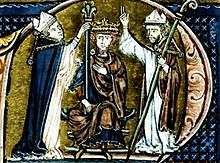
- Godfrey of Bouillon (c.1060–1100), Count of Boulogne, prominent figure in the First Crusade
- Baldwin I of Jerusalem (c.1058–1118), Count of Boulogne, prominent figure in the First Crusade
- Blaise de Monluc (1502–1577), Marshal of France
- Smithson Tennant (1761–1815), chemist, discoverer of osmium and iridium, died falling from a bridge in Boulogne
- Romeo Coates (1772–1848), amateur actor, fled from London to Boulogne to escape debtor's prison. He lived there for several years, and met his wife during this period.
- Adam Liszt (1776–1827), father of Franz Liszt, died from Typhoid fever while on a vacation
- José de San Martín (1778–1850), Argentine general who liberated Argentina, Chile and Peru; lived for two years in Boulogne and died there
- Benoît-Agathon Haffreingue (1785–1871), priest and builder of Boulogne's cathedral
- Félix Godefroid (1818–1897), Belgium-born composer, grew up in Boulogne
- Constant Coquelin (1841–1909), actor
- John McCrae (1872–1918), Canadian doctor, poet; author of In Flanders Field
- Alfred-Georges Regner (1902–1987), painter-engraver
- Maurice Boitel (1919–2007), painter
- Olivier Latry (born 1962), musician, educator
International relations
Twin towns — Sister cities
Boulogne-sur-Mer is twinned with:
 Constanta, Romania
Constanta, Romania Folkestone, Kent, United Kingdom[18]
Folkestone, Kent, United Kingdom[18] La Plata, Argentina
La Plata, Argentina Safi, Morocco - since 2007
Safi, Morocco - since 2007 Zweibrücken, Germany - since 1959
Zweibrücken, Germany - since 1959
See also
References
- ↑ "C'est l'Actu juillet 2010". Ville-boulogne-sur-mer.fr. Retrieved 2013-03-26.
- ↑ France. "Ville de Boulogne-sur-Mer - La Commune, la Mairie de Boulogne-sur-Mer et sa ville - Pas-de-Calais en France". Annuaire-mairie.fr. Retrieved 2013-03-26.
- ↑ Graeme Villeret. "France". PopulationData.net. Retrieved 2013-03-26.
- ↑ "Boulogne-sur-Mer Tourist Guide". Information France. 2010-06-01. Retrieved 2013-03-26.
- 1 2 "Les Beffrois au patrimoine de l'Humanité". Nordmag.fr. Retrieved 2013-03-26.
- ↑ "Données climatiques de la station de Boulogne-sur-Mer" (in French). Meteo France. Retrieved January 8, 2016.
- ↑ "Climat Nord-Pas-de-Calais" (in French). Meteo France. Retrieved January 8, 2016.
- ↑ "Normes et records 1961-1990: Boulogne (62) - altitude 73m" (in French). Infoclimat. Retrieved January 8, 2016.
- 1 2 3 4 "Boulogne-sur-Mer (Municipality, Pas-de-Calais, France)". Flagspot.net. Retrieved 2013-03-26.
- ↑ Nixon, C.E.V. In Praise of Later Roman Emperors: The Panegyrici Latini: Introduction, Translation, and Historical Commentary with the Latin Text of R.A.B. Mynors, "VI. Panegyric of Constantine, by an Anonymous Orator (310)", p. 223–224, n. 19. University of California Press (Los Angeles), 1994. ISBN 0-520-08326-1.
- ↑ Historia Nova, Book VI.5.2-3
- ↑ DeSmet, W.M.A. (1981). "Mammals in the Seas: General papers and large cetaceans. Whaling During the Middle Ages.".
- ↑ http://www.cwgc.org/find-a-cemetery/cemetery/4800/BOULOGNE%20EASTERN%20CEMETERY
- ↑ "2nd Battalion Irish Guards. - World War 2 Talk". Ww2talk.com. Retrieved 2012-07-03.
- ↑ Stacey, C P (1966). "Clearing the Coastal Belt and the Ports September 1944 - Operation "WELLHIT"; The Capture of Boulogne". Official History of the Canadian Army. Department of National Defence. Retrieved 24 June 2009.
- ↑ "Football Boulogne : Union Sportive Boulogne Côte d Opale (USBCO)". Foot-national.com. Retrieved 2013-03-26.
- ↑ Franck Ribéry - Goal.com
- ↑ "British towns twinned with French towns [via WaybackMachine.com]". Archant Community Media Ltd. Archived from the original on July 5, 2013. Retrieved 2013-07-12.
Further reading
- "Boulogne", A Handbook for Travellers in France (8th ed.), London: John Murray, 1861
- "Boulogne-sur-Mer", Northern France (3rd ed.), Leipsic: Karl Baedeker, 1899, OCLC 2229516
- "Boulogne sur Mer", Encyclopædia Britannica, 9th ed., Vol. IV, New York: Charles Scribner's Sons, 1878, pp. 171–172.
- "Boulogne-sur-Mer", Encyclopædia Britannica, 11th ed., Vol. IV, Cambridge: Cambridge University Press, 1911, pp. 323–324, OCLC 14782424.
External links
| Wikinews has related news: French fishermen blockade Channel ports |
| Wikimedia Commons has media related to Boulogne-sur-Mer. |
| Wikisource has the text of the 1911 Encyclopædia Britannica article Boulogne-sur-Mer. |
| Wikivoyage has a travel guide for Boulogne-sur-Mer. |
- INSEE (English)
- IGN (English)
- Official website: Tourism in Boulogne sur Mer and the Boulonnais area (in English)
- Boulogne-sur-Mer city council website (in French)
- Visiting Boulogne-sur-Mer (English guide and tourist map)
- NAUSICAÄ's official website (in French and English)
- Boulogne 2005 Esperanto
- Universite d'ete de Boulogne-sur-Mer
- The university library of ULCO
- The Boulogne Eastern Cemetery on the website "Remembrance Trails of the Great War in Northern France"
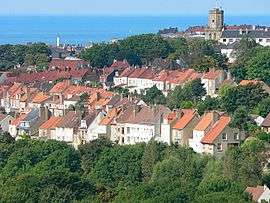
.svg.png)